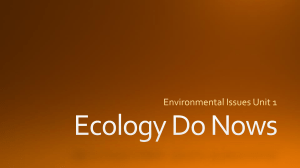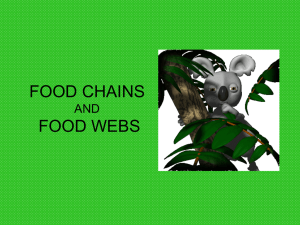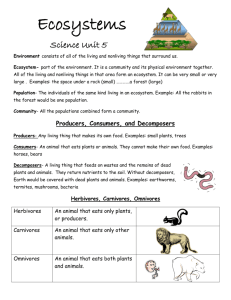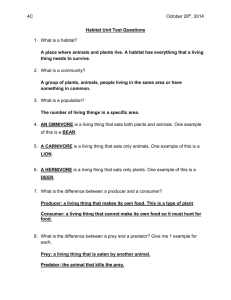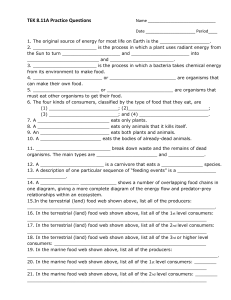Chapter 5 Food Chains B40 Lesson Preview LESSON 1 From birds
advertisement
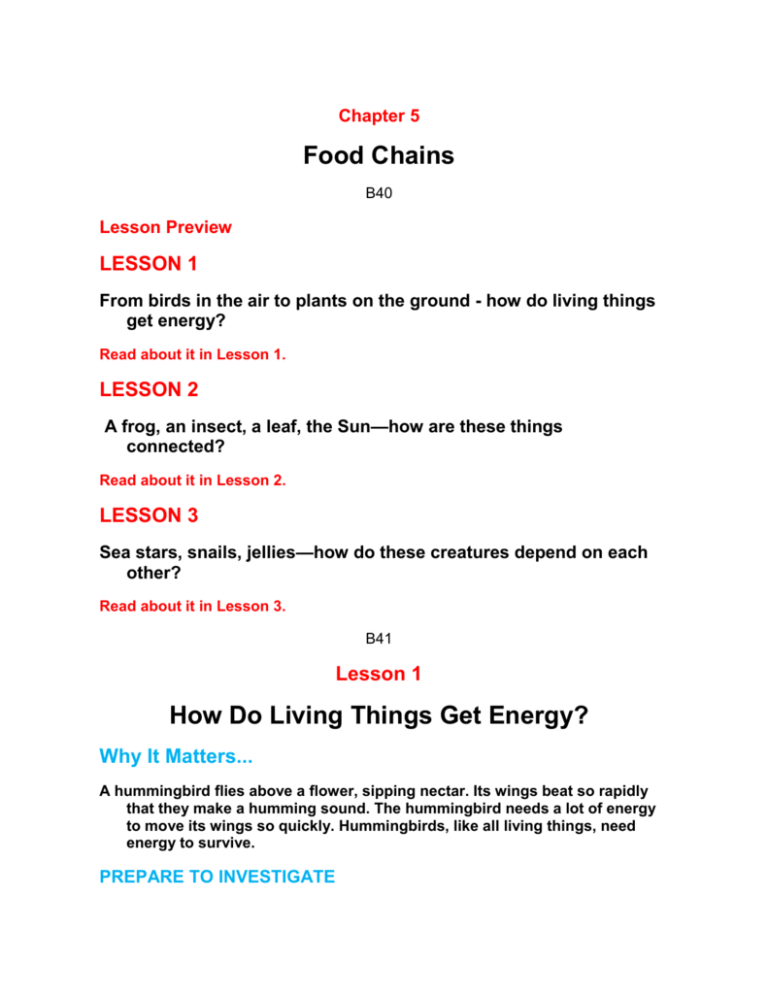
Chapter 5 Food Chains B40 Lesson Preview LESSON 1 From birds in the air to plants on the ground - how do living things get energy? Read about it in Lesson 1. LESSON 2 A frog, an insect, a leaf, the Sun—how are these things connected? Read about it in Lesson 2. LESSON 3 Sea stars, snails, jellies—how do these creatures depend on each other? Read about it in Lesson 3. B41 Lesson 1 How Do Living Things Get Energy? Why It Matters... A hummingbird flies above a flower, sipping nectar. Its wings beat so rapidly that they make a humming sound. The hummingbird needs a lot of energy to move its wings so quickly. Hummingbirds, like all living things, need energy to survive. PREPARE TO INVESTIGATE Inquiry Skill Compare When you compare two things, you observe how they are different and how they are alike. Materials 2 plastic cups containing soil and grass seedlings marking pen metric ruler aluminum foil plastic wrap plastic spoon water Science and Math Toolbox For step 2, review Using a Tape Measure or Ruler on page H6. B42 Investigate Soak Up the Sun Procedure 1 Collaborate Work with a partner. Use a marking pen to label one cup of grass seedlings Light. Label another cup Dark. In your Science Notebook, make a chart like the one shown. 2 Measure Measure the height of the grass in each cup. Record the measurements on your chart. 3 Count as you add spoonfuls of water to one cup until the soil is wet. Add the same amount of water to the other cup. 4 Use Variables Use aluminum foil to wrap the Dark cup. Use plastic wrap to wrap the Light cup. Place both cups where they will receive indirect sunlight. 5 Record Data After 5 days, unwrap both cups. Observe the appearance of the grass. Then measure and record the height of the grass in each cup. Conclusion 1. Compare In which cup did the height of the grass increase? 2. Infer Plants need energy to grow. How do you think the grass plants got the energy to grow? Investigate More! Design an Experiment Does the amount of water grass gets affect how it grows? Write a hypothesis to explain what you think. Then, plan and carry out an experiment to find out. Share your results. B43 Learn by Reading VOCABULARY cell p. B45 solar energy p. B44 READING SKILL Main Idea and Details As you read, record one main idea and two details for each section. Getting Energy MAIN IDEA All organisms need energy to grow and survive. The Sun is the source of energy for almost all living things. Energy from the Sun Imagine a bright winter day. The air is cold, but your face feels warm as you tilt it toward the Sun. Sunlight feels warm on your face because light is energy. Energy is the ability to cause change. Energy that comes from the Sun is called solar energy. Solar energy provides Earth with light and heat. Light and heat are energy. The Sun provides energy that plants need to make food. Most living things could not exist without solar energy. Plants use sunlight to make food. B44 Plants Make Food How does a plant get something to eat? It doesn't. Plants make food using water, air, and sunlight. The food they make is called sugar. And although plants don't "eat," they do use the food they make. Plants use the energy in the food they make to survive, to grow, and to make new plants. Dandelions use the food they make to produce new flowers. Apple trees make apples. Moss spreads and makes new plants. Plants store some of the food they make in their cells (sehlz). A cell is the basic unit that makes up all living things. Plants can use this stored food when the Sun is not shining. MAIN IDEA What do plants need to make food? Almost all energy on Earth comes from the Sun. Plants use the food they make to survive. B45 Animals Get Energy from Plants Unlike plants, animals can't make food. Animals must take in food in order to get the energy that they need to survive. When an animal eats, the energy is transferred from the food source to that animal. Many animals eat plant parts. Each time an animal eats a plant, energy is transferred from the plant to that animal. Not all of the energy that a plant gets from the Sun is transferred to an animal that eats the plant. Some energy is used by the plant for its survival. Some is stored in the plant's cells. MAIN IDEA How do animals get energy from plants? A tomato plant stores energy from the Sun. Animals get some of this energy by eating the plant. slug human groundhog crow B46 Lesson Wrap-Up Visual Summary Energy from the Sun is called solar energy. Plants use energy from the Sun to make food. Animals that eat plants get energy from plants. WRITING Expository People have been growing crops for thousands of years. Modern scientists use technology to improve crops. Research the history of farming. Write a paragraph about a new technology that farmers are using today. HEALTH Make a Chart Nutrients are in food. Nutrients include sugar, protein, fat, vitamins, and minerals. List the main ingredients of your favorite food. Make a chart that shows each ingredient, its animal or plant source, and the nutrients it provides. Review 1 MAIN IDEA Why do living things need energy? 2 VOCABULARY Write a sentence using the term solar energy. 3 READING SKILL Main Idea and Details List three details that support the idea that some animals get energy from plants. 4 CRITICAL THINKING: Synthesize A population of grass-eating leafhoppers live in a field. What would happen if all the grass in the field died? 5 INQUIRY SKILL: Compare How does the way plants get energy compare with the way animals get energy? TEST PREP Plants survive by _____. A. getting food from water in the soil B. making food from water, air, and sunlight C. getting food from the air D. using energy from animals Technology . . Visit www.eduplace.com/scp/ to find out more about how living things get energy. B47 Lesson 2 What Is a Food Chain? Why It Matters... Zip! A frog's long, sticky tongue flicks out of its mouth and captures an insect—the frog's next meal. What might the insect have eaten for its last meal? And will another living thing eat the frog? All animals must eat food, and most animals are food for others. PREPARE TO INVESTIGATE Inquiry Skill Classify When you classify, you sort things into groups according to their properties. Materials plant and animal picture cards string scissors construction-paper Sun transparent tape B48 Investigate Food-Chain Mobile Procedure 1 Collaborate Work in a group. Use tape to attach a paper Sun to a string. Cut out a set of picture cards. 2 Classify Find the two living things that use sunlight to make food. Use string and tape to hang one of these cards from the Sun. Look at the remaining picture cards. Find the animals that eat plants. Hang one of these cards from the hanging plant card. 3 Classify Now, find the animals that eat other animals. Hang one of these cards from the hanging plant-eater card. You have made a model of a food chain. A food chain shows how organisms get energy. 4 Use Models Cut the string that connects the plant card to the plant-eater card. 5 Repeat steps 2-4 with the other cards. Conclusion 1. Infer How could you organize your mobile using other card groupings? 2. Use Models Think about step 4. How would animals be affected if the plants they ate died out? Investigate More! Research Choose a plant-eating animal from your mobile. Do research to learn which plants this animal eats. Find out which animals eat this animal. Make a mobile to present to the class. B49 Learn by Reading VOCABULARY food chain p. B50 producer p. B51 consumer p. B51 carnivore p. B51 herbivore p. B51 omnivore p. B51 READING SKILL Sequence Use the chart to trace the flow of energy in a food chain. Start with the Sun. Food Chains MAIN IDEA When one animal eats another animal or eats a plant, it becomes part of the flow of energy in a food chain. Links in the Chain Suppose you labeled each link of a paper chain with the name of an organism. If each organism was linked to an organism that it used for food, you would have a model of a food chain. A food chain is the path that energy takes through a community as one living thing eats another. All animals depend on plants for their energy. When an insect eats a plant and then a frog eats that insect, energy is passed from organism to organism. The plant produced its own food using the energy in sunlight. Some of the Sun's energy captured by the plant passed to the insect and then to the frog. Savanna Food Chain Producer Savanna grass uses sunlight to make food. B50 Parts of a Food Chain No matter what organisms are part of a food chain, the Sun is always the first link in the chain. Plants are the second link. A plant is called a producer (pruh DOOsur) because it produces its own food. An animal is a consumer (kuhn SOO mur). A consumer is an organism that eats other living things in order to get energy. Consumers are classified by their food source. An animal that eats only other animals is a carnivore (KAHR nuh vawr). Lions, hawks, and spiders are carnivores. An animal such as a zebra, horse, or deer that eats only plants is an herbivore (HUR buh vawr). An animal that eats both plants and animals is an omnivore (AHMnuh vawr). Most humans are omnivores, although some people are vegetarians. That means they don't eat meat. Producers, carnivores, herbivores, and omnivores are all parts of a food chain. SEQUENCE Why can't a consumer be the first link in a food chain? Herbivore The Zebra is a consumer that eats only plants. Carnivore The lion is a consumer that eats only other animals. B51 Linked Food Chains An African savanna is home to many producers and consumers. These organisms form links in different food chains. Grasses, bushes, and trees are the producers in the savanna. ---see pictures Lions are carnivores. They hunt and eat zebras and gazelles. Fire ants are omnivores that eat almost anything they can find. They eat grass seeds, small insects, and even small birds. B52 Ostriches are omnivores. They eat seeds, grasses, bushes, and tree leaves. Ostriches also eat small animals, such as mice. The rhinoceros, hippopotamus, giraffe, and zebra are all herbivores. They eat only plants. Oxpeckers are birds that are carnivores. They perch on the back of the rhinoceros and eat ticks that can harm it. B53 Energy from Food How are the living things shown here linked by a flow of energy? Grass uses solar energy to make and store food in its cells. When cattle eat grass, some of the stored energy is transferred to the cells of the animal's body. Some of this energy is stored in the cells, which may eventually end up in the meatballs. When a person eats this meal, some of the energy is transferred into that person's cells. A tomato plant also uses solar energy to make food. When people eat tomatoes, some of the energy that was stored in the tomato is transferred to them. Spaghetti is made from wheat. Wheat plants use solar energy to make food. Humans get some of this stored energy when they eat spaghetti. Plants are always the first living link in a food chain. The person who eats a meal is the last link in the food chain. SEQUENCE What organisms are at the beginning of all food chains? ---see pictures The energy from the food in this meal originally came from plants. B54 Lesson Wrap-Up Visual Summary Plants are producers. Plants are the first living link in every food chain. Herbivores eat only plants. Carnivores eat only other animals. Animals that eat plants and also eat other animals are omnivores. LINKS for Home and School MATH Multiply With 100 One 8-pound eagle must eat 8 rabbits to get enough energy to survive. Each rabbit must eat 100 pounds of grass. How many pounds of grass must be in the food chain so that one eagle can get enough energy? LITERATURE Write a Song or Poem Some poems or songs repeat lines, and then add a new line at the end of each verse. One popular song of this kind is "I Knew an Old Lady Who Swallowed a Fly." Write a song or a rhyme about a food chain using this repeating style. Review 1 MAIN IDEA What is a food chain? 2 VOCABULARY Write a short paragraph using the terms producer and consumer. 3 READING SKILL: Sequence Describe the correct sequence of a food chain that has a carnivore, a producer, and an herbivore. 4 CRITICAL THINKING: Analyze What are the relationships among a carnivore, an herbivore, and an omnivore? 5 INQUIRY SKILL: Classify Suppose an animal eats only mosquitoes. Is the animal a producer or a consumer? If you classify it as a consumer, what kind of consumer is it? TEST PREP Which of the following is an example of an herbivore? A. rabbit B. lion C. maple tree D. hawk Technology Visit www.eduplace.com/scp/ to discover more about food chains. B55 Focus On Technology Exploring Underwater In 1977, a submersible called Alvin allowed scientists to dive deeper than ever before. Scientists used the Alvin to explore the bottom of the ocean. There, they discovered many new life forms, including the giant tubeworm. Tubeworms are worms that can be as long as 2.4 m (8 ft). They have no mouth or eyes. Until the discovery of the tubeworm, scientists believed that all food chains began with energy from the Sun. When scientists studied this amazing animal, they learned something that surprised them. Tubeworms contain bacteria that change chemicals in the water into food for the tubeworms. ---see picture The Alvin was built in 1964. It was rebuilt and improved in 1977. These changes made it possible for the Alvin to dive to the ocean floor. B56 Tubeworms live thousands of meters below the surface, where sunlight cannot reach them. These giant worms live in openings in the ocean floor called hydrothermal vents. The vents shoot out water that is more than 400°C (752°F). Sharing Ideas 1. READING CHECK What was the importance of the Alvin? 2. WRITE ABOUT IT Write a paragraph explaining how a food chain with a tubeworm is different from a food chain with a land animal. 3. TALK ABOUT IT Discuss an invention that has helped people make discoveries or learn new things. B57 Lesson 3 What Are Some Different Food Chains? Why it Matters... Food chains exist wherever living things are found. In an ocean food chain, tiny floating plants and seaweed use solar energy to make food. The fish eat the plants and seaweed. Later, some of the fish may become a meal for a shark. PREPARE TO INVESTIGATE Inquiry Skill Research When you do research, you learn more about a subject by looking in books, searching the Internet, or asking science experts. Materials plant and animal picture cards Science and Math Toolbox For step 1, review Making a Chart to Organize Data on page H10. B58 Investigate Match Things Up Procedure 1 Collaborate Work in a group. In your Science Notebook, make a chart like the one shown. 2 Classify Cut out a set of plant and animal picture cards provided by your teacher. Find cards that show plants and animals that live in a desert. Group these cards together. Write the names of these organisms in your chart. 3 Research Repeat step 2 for an ocean environment and for a rainforest environment. If necessary, use reference books or the Internet to check where an organism lives. 4 Use Models When all of the organisms have been classified in your chart, make a food chain for each environment. Line the cards up in order. Each food chain should start with a producer. Write or draw each food chain in your Science Notebook. Conclusion 1. Infer What is the role of the Sun in each food chain? 2. Communicate Explain why you arranged each food chain the way you did. Investigate More! Solve a Problem Suppose you want to set up an aquarium with several kinds of fish. What would you need to know about the fish's food chains? B59 Learn by Reading VOCABULARY aquatic habitat p. B60 terrestrial habitat p. B62 READING SKILL Compare and Contrast Use a chart to compare and contrast food chains in aquatic habitats and terrestrial habitats. Food Chains in Environments MAIN IDEA Food chains exist wherever living things are found. The organisms in each food chain vary based on their environment. Food Chains in Water Animals live in many different places, or habitats. Tide pools are the habitat of some ocean animals. A tide pool is an area at the edge of the ocean where water collects in spaces between rocks. A tide pool is one kind of aquatic (uhKWAT ihk) habitat. An aquatic habitat is a place where organisms live in or on water. In tide pools, seaweed and algae are the producers. Like producers on land, they use the energy from sunlight to make food. ---see pictures Portuguese man-of-war periinkle minnow shrimp blue crab bladderwort seaweed oystercatcher bird cordgrass blue crab sea star oyster B60 An aquatic habitat is also home to herbivores, carnivores, and omnivores. Look at the picture of the tide pool. What food chains can you find? COMPARE AND CONTRAST Compare a produces that lives in an aquatic habitat with one that lives on land. Tide Pool Food Chain Cordgrass This grass captures energy from the Sun to make food. Periwinkle snail This snail eats and scrapes plants from rocks with its mouth. Blue crab This crab uses its strong claws to capture and eat snails. B61 Food Chains on Land People live in terrestrial (tuh REHS tree uhl) habitats. A terrestrial habitat is a place where organisms live on land. A desert is one kind of terrestrial habitat. Desert regions usually get little rainfall, so they are very dry. Organisms that live in the desert are adapted to the dry conditions there. Desert producers include grasses, wildflowers, and cactuses. Cactuses store large amounts of water in their cells. Desert herbivores include insects and small animals like rabbits. Desert herbivores that eat cactus are able to get both energy and water from the plants they eat. Desert Food Chain Evening primrose This plant blooms at night, when desert temperatures are cool. Antelope squirrel This squirrel eats primrose, seeds, and small animals. Rattlesnake This snake eats rabbits, mice, squirrels, and birds. B62 Snakes are common desert carnivores. They capture and eat lizards, birds, and small animals. Hawks, owls, and vultures feed on animals such as snakes, mice, and rats. Food is difficult to find in the desert. This may be why many desert animals are omnivores. An animal is less likely to go hungry when its diet includes both plants and animals. But, in all terrestrial food chains, each animal depends on the plant that is at the start of the food chain. COMPARE AND CONTRAST How are snakes and hawks similar? ---see pictures prickly pear cactus black-collared lizard road runner white-tailed antelope squirrel organ pipe cactus turkey vulture North American jackrabbit diamondback rattlesnake evening prinifose The organisms in a desert form many food chains. Each food chain starts with a producer that uses the Sun as its energy source. B63 Lesson Wrap-Up Visual Summary Food chains in aquatic habitats are made up of plants and animals that live in or on water. Food chains in terrestrial habitats are made up of plants and animals that live on land. LINKS for Home and School MATH Draw Lines of Symmetry Suppose that an enormous sea star has been discovered in the Pacific Ocean. Draw the sea star with five arms. Draw a line of symmetry. Suppose the sea star loses one arm, and in its place two new arms grow back. Draw the sea star with its new arms. Does it have the same line of symmetry as the first sea star you drew? SOCIAL STUDIES Write a Journal Entry The Inuit are a people who live near the ocean in the snowy Arctic. The Yanomano live in the hot rainforests of South America. Imagine you have traveled to visit both groups. Write a journal entry comparing the food sources of each group. Review 1 MAIN IDEA What do food chains in aquatic and terrestrial habitats have in common? 2 VOCABULARY What does terrestrial habitat mean? 3 READING SKILL: Compare and Contrast How are food chains in aquatic and terrestrial habitats different? 4 CRITICAL THINKING: Apply What would happen to the number of herbivores in a food chain if most of the producers disappeared? 5 INQUIRY SKILL: Research How could you find out what food is best to feed a pet iguana? TEST PREP In an aquatic habitat, the producer in a food chain ___. A. gets its food from water. B. is likely to be an herbivore. C. uses solar energy to make food for other producers. D. uses solar energy to make its own food. Technology Visit www.eduplace.com/scp/ to find out more about terrestrial habitats. B64 Careers in Science Soil Conservationist Soil conservationists are experts on soil. They develop ways to help farmers keep their land fertile, moist, and rich in nutrients. They also advise government agencies and businesses on how to use land without harming it. What It Takes! A degree in environmental studies, forestry, or agriculture Investigative and research skills Ecotourist Guide As an ecotourist guide, you could find yourself leading safaris in Africa, exploring South American rainforests, or hiking glaciers in Alaska. Ecotourist guides take adventure-seekers on vacations to natural areas. They teach people about protecting wildlife and the environment. What It Takes! A high-school diploma An interest in nature, ecology, and adventure B65 EXTREME Science Big Mouth! Its jaws are as long as a rowboat. The amount of food it eats each day can weigh more than a car. So this humpback whale must eat lots of really big fish--right? Wrong! The humpback mainly eats krill—tiny creatures, smaller than your pinky. Why? Krill are one of the most plentiful foods in the ocean. They are part of a food chain that begins with tiny ocean plants called phytoplankton. Krill eat these microscopic plants, and whales and many fish eat the krill. There are so many krill in the ocean, the humpback can eat them by the ton! ---see picture The krill is a crustacean, similar to a shrimp. It has a hard shell and no backbone. B66 READING LINK :Compare and Contrast ---see picture No teeth, no problem! Instead of teeth, the humpback has baleen. These comb-like plates hang from the whale's upper jaw. The whale scoops up water in its huge mouth and squeezes it through the baleen, which traps the krill. B67 Chapter 5 Review and Test Prep Vocabulary Complete each sentence with a term from the list. 1. The path that energy takes through a community as one living thing eats another is a/an _____. 2. An animal that eats only plants is a/an _____. 3. Lions, zebras, and grass are all found in a/an _____. 4. An organism that makes its own food is a/an _____. 5. An animal that only eats animals is a/an _____. 6. Plants are able to make food by capturing _____ from the Sun. 7. An organism that eats other living things in order to get energy is a/an 8. Fish and other water organisms live in a/an _____. 9. The basic unit that makes up all living things is a/an _____. 10. An animal that eats both plants and animals is a/an _____. aquatic habitat B60 carnivore B51 cell B45 consumer B51 food chain B50 herbivore B51 omnivore B51 producer B51 solar energy B44 terrestrial habitat B62 Test Prep Write the letter of the best answer choice. 11. Which is a terrestrial habitat? A. desert. B. river. C. ocean. D. lake. 12. In the following food chain, the producer is the _____. _____. plant caterpillar bird cat A. bird. B. caterpillar. C. plant. D. cat. 13. In a food chain, consumers _____. A are usually the first link in the chain. B. eat other living things. C. use solar energy to make food. D. get energy from air. 14. The organism that would most likely be last in a food chain is a _____. A. seaweed. B. human. C. maple tree. D. caterpillar. B68 Inquiry Skills 15. Classify Classify each organism in this food chain as a producer or consumer. grass cow human 16. Compare Suppose a tree is planted in a small grassy field. As years pass, the tree grows. Over time, the grass beneath the tree dies. For what reason might the grass die? Compare the conditions for grass growing under the tree with the conditions for grass growing in the rest of the field. Map the Concept The chart shows two categories. Classify each organism on the list. Check that you have placed each organism in the correct category. dandelion crab seaweed grass squirrel zebra 17. Apply A sparrow, a hawk, a rosebush, and a beetle are links in the same food chain. Put the parts of the food chain in order to trace the path of energy. What is the original source of the energy in the food chain? 18. Synthesize A plant on your dresser appears to be dying. Your friend suggests that you move the plant to a windowsill. What does your friend think the plant needs? 19. Evaluate Suppose you had to prepare a classroom display of pet animals. Your classmates have brought a turtle, a frog, a snake, and a hamster for the display. How would you decide which animals, if any, could be displayed together in the same container? 20. Analyze If living conditions became difficult, why might an omnivore be better able to survive than either an herbivore or a carnivore? Performance Assessment Plan a Dinner Choose one of the three kinds of consumers: herbivore, omnivore, or carnivore. Plan a dinner menu for your consumer. Be creative. You might include a soup, a salad, a main course, and a dessert. Describe the ingredients in each of the menu items. Explain why your consumer would eat each menu item. B69 UNIT B Review and Test Prep Write the letter of the best answer choice. 1. Which is NOT an example of a structure that is an adaptation? A. needle shaped leaves B. suction cups on the arm of a sea star C. the long, thin beak of a hummingbird D. a cat sneaking up on a mouse 2. Which is the source of energy for plants? ---see pictures 3. For which resource do squirrels and birds drinking from a birdbath compete? A. air B. food C. space D. water 4. Which organism in this food chain is an herbivore? A. coyote B. day lily C. rat D. snail 5. BOTH plants and animals . A. reproduce. B. give off oxygen. C. look for a home. D. use sunlight directly for energy. 6. Which is MOST likely to be an adaptation for self-defense? A. the thick fur coat of a bear B. a thick plant stem that stores water C. the webbed feet of a bird that lives in water D. a rabbit that has brown fur in summer and white fur in winter B70 7. Which is NOT an adaptation of a living thing to its environment? A. the very sharp claws of a cat B. the thick winter coat of a rabbit C. the spines that cover a desert cactus D. the very long stem of a rainforest plant 8. Which organism could be a consumer in an aquatic habitat? ---see pictures Answer the following in complete sentences. 9. Beavers build a dam across a stream. Which is likely to benefit MORE from the dam—the fish in the stream or the trees along the stream? Explain your answer. 10. The following organisms live in a desert habitat. ---see pictures Which two organisms are most likely to compete for food? Explain why you made your choice. B71 UNIT B Wrap-Up Discover! Polar bears are adapted to the cold, icy environment of the Arctic. Thick fur and a layer of fat keep them warm in freezing temperatures. Even their paws are adapted for their environment. These adaptations make it easy for polar bears to walk on ice without slipping. Polar bears have four paws that can be over 25 cm (about 10 in.) wide. Each paw has five toes, and each toe has a long sharp claw. These claws help polar bears grip the ice. Each polar bear paw has seven footpads. The footpads are made of a thick, black layer of skin and are covered with small bumps. The bumps on the bear's footpads are like the treads on a sport shoe. They grip the ice and keep the bear from slipping when it runs. Long fur between the footpads and toes keeps polar bears from slipping, too. Webbing that is under the fur between the toes helps polar bears swim. Learn more about animal adaptations. Go to www.eduplace.com/scp/ to see how polar bears and other animals adapt to their environments. B72




